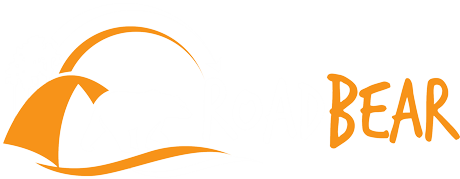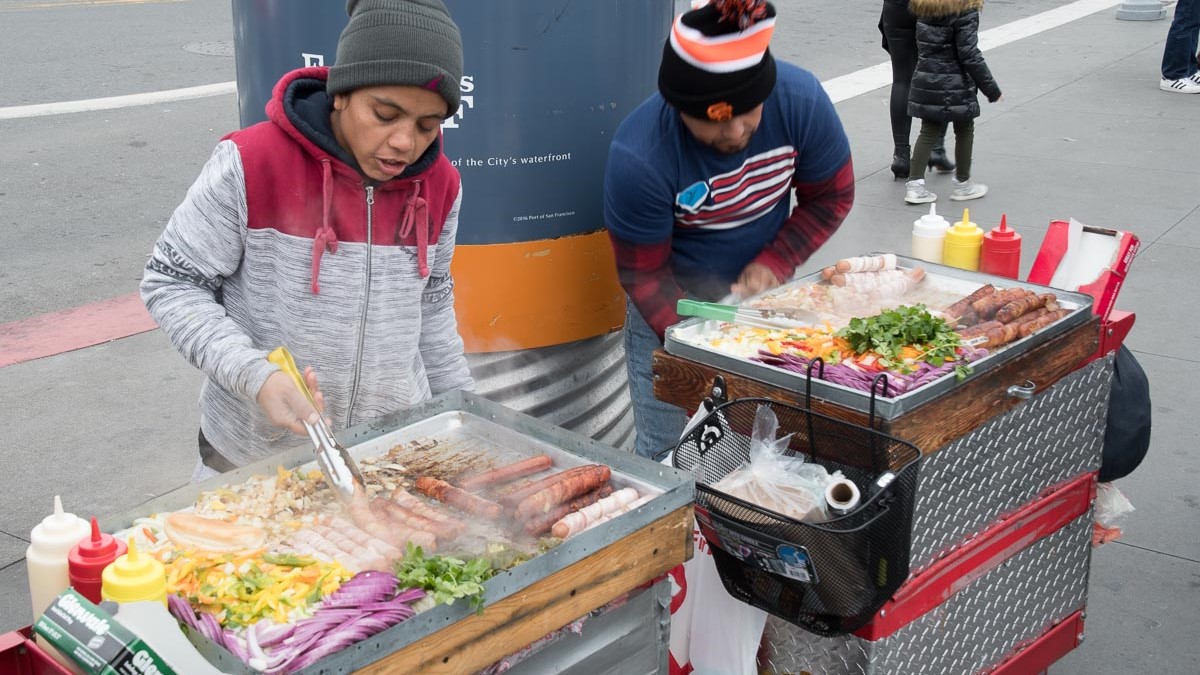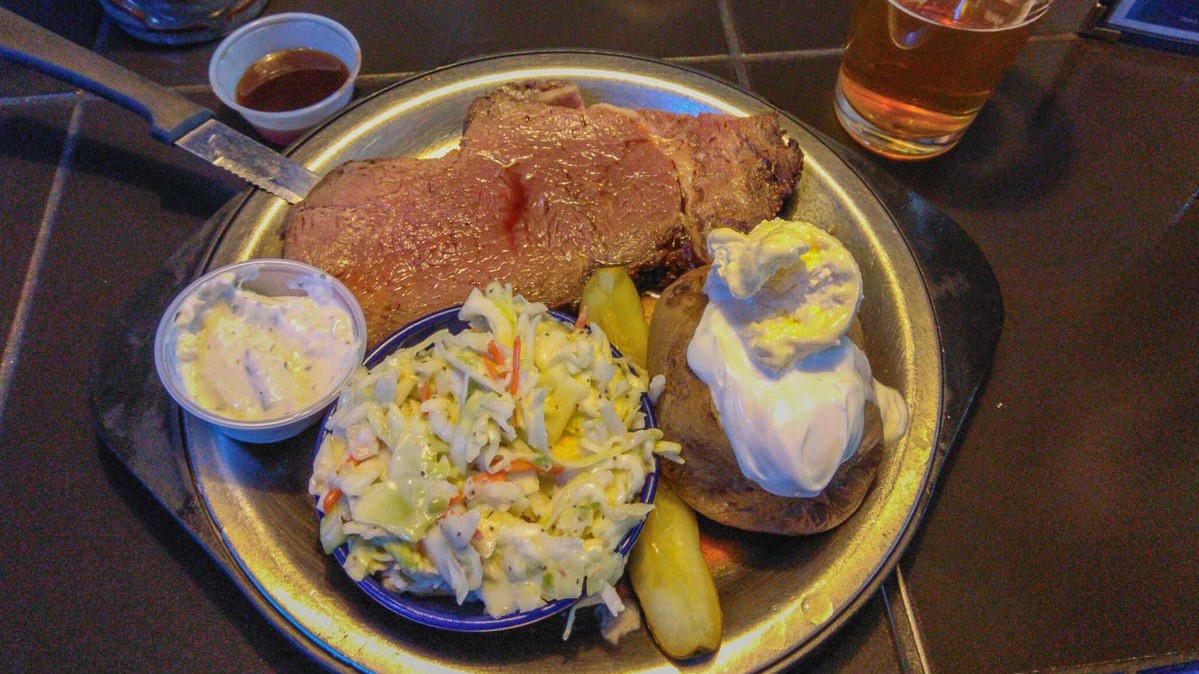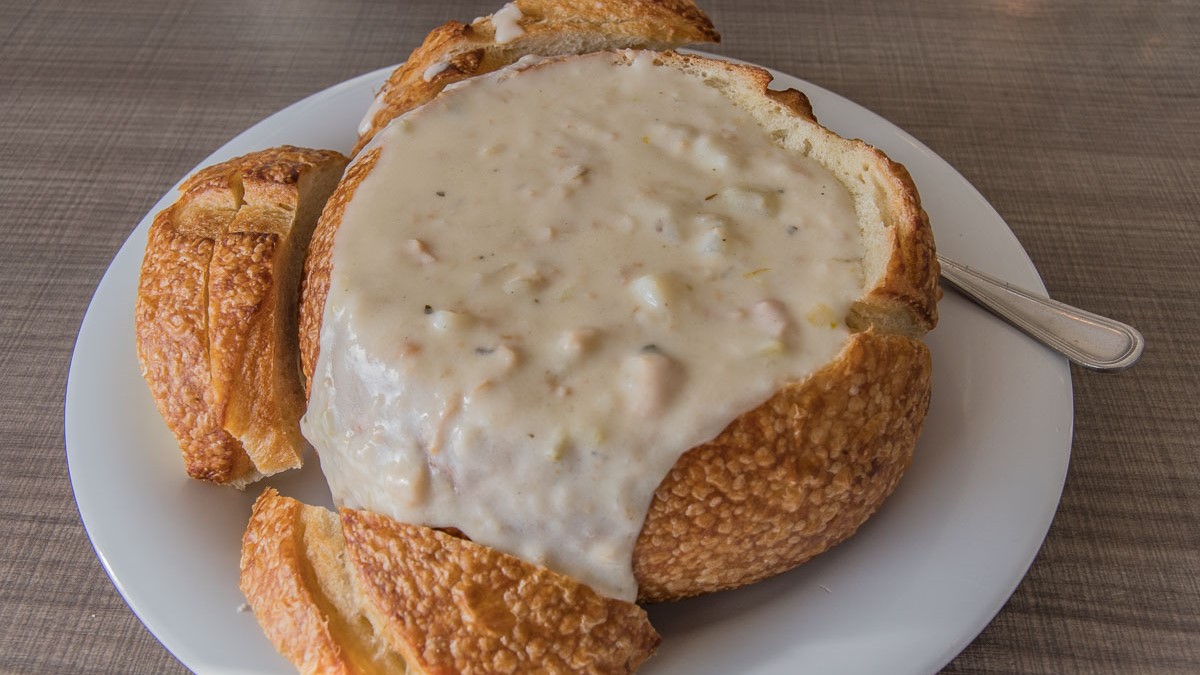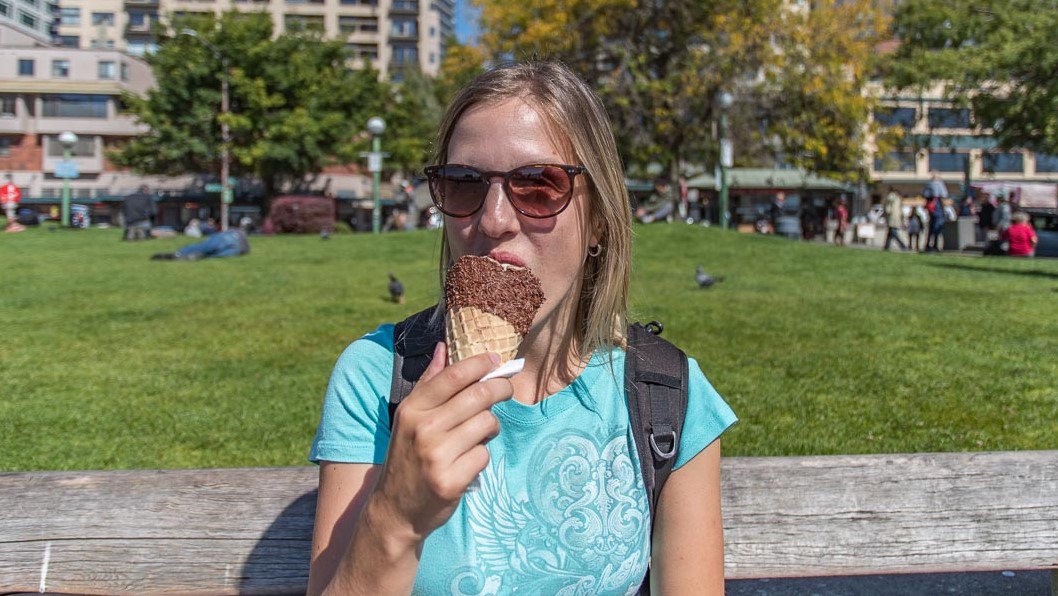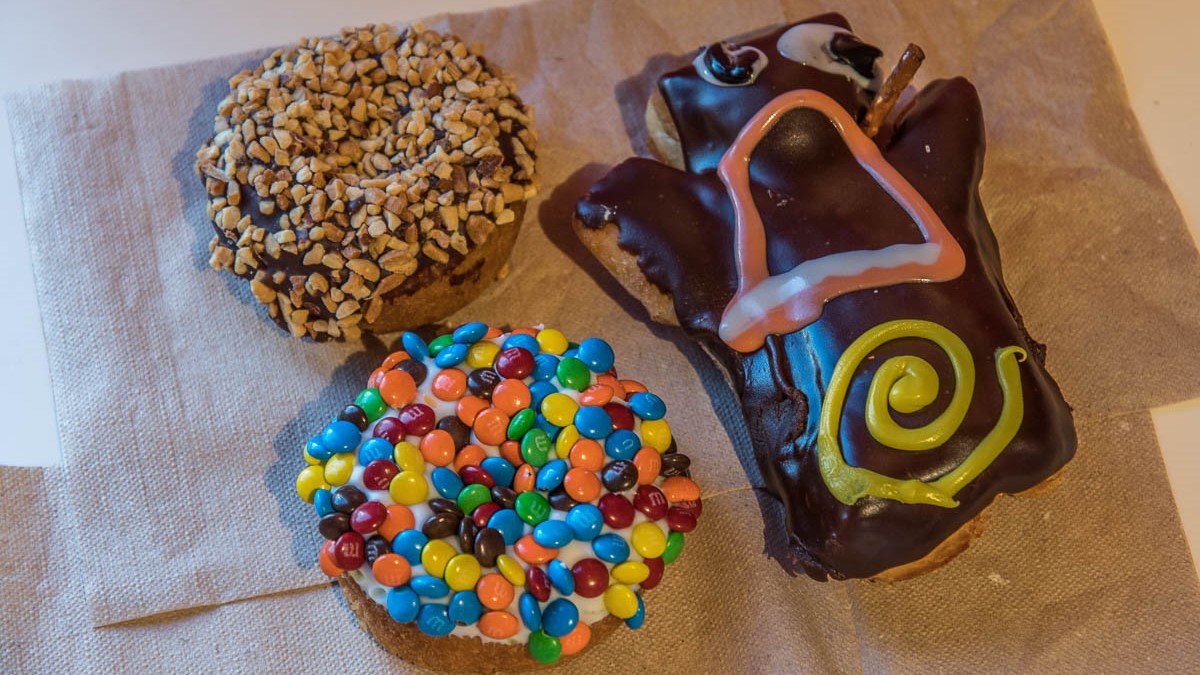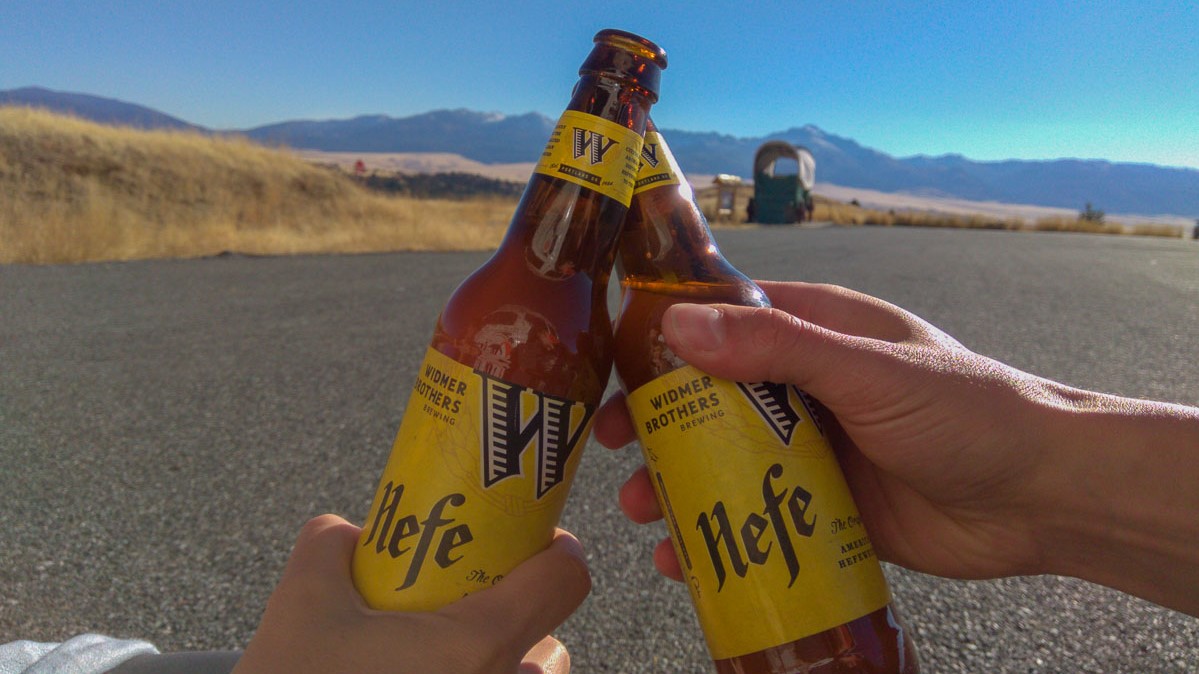Already three weeks after the start of our trip we passed an international border in Niagara Falls for the first time and arrived in the USA. Our first impressions of the new country and the border town Buffalo were: Unfriendly border officials, incredibly cheap diesel and incredibly rusted cars ... so not only positive.
Nevertheless, the new landscape was able to convince us from the very first moment. When we found beaches along Lake Erie and Lake Michigan that are otherwise only known from the glossy catalogues of tour operators for exotic destinations, we knew that we would get our money's worth in the next six months.
In the first three weeks we already experienced the whole range of things that make the USA so fascinating for us. We spent exciting hours in vibrant cities like Chicago or Cleveland, got to know and appreciate the incredible hospitality of many Americans when Toby spontaneously invited us to his home, and travelled through areas like the Badlands or the Yellowstone National Park with breathtaking scenery that doesn't seem to be of this world.
Beyond all the positive experiences we had to accept our first breakdown after only one month travel time on the whole Panamericana. A stuttering engine forced us to interrupt our journey for one week in Cody, Wyoming. But once the problem was solved, there was no stopping...
via the Glacier National Park we left the USA for Canada, but before that we enjoyed two wonderful days at Bowman Lake with Melissa and John, whom we met at a gas station. On our whole trip to the uppermost north of Canada the winter was always on our backs, which led us to flee to the south early. By mid-September 2018 we had already covered the entire distance from the Arctic Sea to the US-Canadian border and arrived in the state of Washington.
The northwest of the USA surprised us with unexpected diversity: volcanoes, wild romantic coasts, good food, rainforests and high deserts are only a few reasons that we liked this part of the USA very much and we felt very comfortable. Last but not least the many acquaintances we have in Oregon and who we visited certainly contributed to this. Above all Brandt's, with whom Alexandra completed a language stay in 2005 and with whom we now lived for almost three weeks and enjoyed the advantages of a real house.
We went on to the southwest of the USA, which in our opinion has the most to offer in terms of scenic highlights. Sometimes it was almost depressing for us to find out that in half a year - which is a lot of time per se - we will see only a fraction of the treasures there are. Nevertheless, we enjoyed about 3 months in the states of Utah, Colorado, New Mexico, Arizona and in the southern parts of Nevada and California. Among our absolute highlights are not only the many national parks, but especially the White Rim Road, an off-road route in Canyonlands National Park, two family visits (once by Mathias' parents and once by Alexandra's sister) and the snowy Grand Canyon, an unforgettable experience, which we had to earn hard with a bitterly cold night (-17°C) before.
ENTRY
12.07.2018 BUFFALO - NEW YORK (Rainbow Bridge)
After crossing the bridge at Niagara Falls we had to stop at one of several customs houses and answer first questions (In which country are you citizens? How long do you want to stay in the USA? etc.). The officer accepted our passports, wanted to know the chassis number of the vehicle and then directed us to park our car and go to the building next door, as the entry for us as persons had to be processed separately.
So we went into the mentioned building next door and had to wait in a waiting room for about 10 minutes until a civil servant asked us to come to him at the counter. Mobile phones were forbidden from this time on. Then we got again some questions asked (Reason of the trip? How long do you want to stay in the USA? What are you by profession?) and had to indicate our exact travel route. After a few grim remarks of the customs officer and the handing in of all our fingerprints as well as an iris scan we got a residence permit of 180 days stamped into the passport and had to pay a fee of 6 USD per person. Our departure date from the USA was 11.01.2019.
17.08.2018 SKAGWAY (Klondike Highway)
The duty is slightly lower than the geographical border. The officer merely checked our passports and asked a few standard questions (whether we were carrying weapons, drugs, etc.). Since we had a valid visa and answered all questions with NO, we could continue directly.
19.08.2018 ALCAN PORT (Alaska Highway)
The official only checked our passports and asked a few standard questions (whether we were carrying weapons, drugs, etc.). Since we had a valid visa and answered all questions with NO, we were able to continue directly.
13.09.2018 BLAINE - WASHINGTON
We didn't get to this busy border crossing until about 8 p.m. and had to wait in line for a long time before we could drive to a customs house. The officer checked our passports and had some small talk with us. Furthermore we had to assure that we didn't carry any fruits (especially oranges) across the border and of course we didn't answer the obligatory questions about weapons and drugs in our luggage. Our car was not checked and we could enter without problems.
DEPARTURE
08.08.2018 CARWAY / 18.08.2018 PLEASANT CAMP (Haines Highway) / 20.08.2018 LITTLE GOLD (Top of the World Highway)
We left the USA without any formalities. As long as you don't exceed the allowed stay of 6 months, you may cross the border between the USA and Canada freely and as often as you like.
10.01.2019 SAN DIEGO (to Tijuana - Mexico)
Driving south from San Diego on Interstate No. 5, you are in Mexico before you know it. Since we left the USA permanently at this border and our visa was expiring, we had to make sure that our I94 form (white note, which was stapled at the first entry into the passport) was removed from the passport again, so that the Americans also know that we have actually left.
Before crossing the border we parked at the "Las Americas Premium Outlets" (No. 1) and walked to the building of the "US Customs and Border Protection" (No. 2). There we wanted to hand over our form to an American official and then drive across the border. The answer was that this was not possible, as we would have to stand on Mexican soil to hand in the form (which actually makes sense!). Otherwise we could turn back and be illegal in the USA...).
For this reason we drove over the border and parked in front of the "Immigration Office" (No. 3) in Mexico. After completing all border formalities for the entry to Mexico we went back to the border over the pedestrian bridge (No. 4) and could hand over our form to an American official from the Mexican side. However, we do not know what he did with the two notes. But at least he seemed to know what the forms were about.
Download Waypoints (KMZ file)
BORDER HYDER / STEWART
In Hyder (Alaska) you will find the Fish Creek, where you can observe salmon migration in August and September and watch bears fishing for salmon. Since Hyder is located in the southernmost tip of Alaska and is surrounded by Canada, or there is no other way to the USA that does not lead through Canada, there is no duty on the US side. However, the Canadians do customs checks and register the passports. We crossed the border several times a day because we spent the night in Stewart (Canada). The control was fast and uncomplicated, the customs officers were mostly on the go for a short chat.
|
Hyder, unlike the rest of Alaska, belongs to the same time zone as the surrounding Canada. So there is no need to change the time here. |
B2-VISUM
Application:
We have already applied for a B2 visa for the USA from Switzerland, which allows us to stay in the country for 6 months instead of the other 3 (with visa-free entry). To get this, the following steps were necessary:
- Fill out form DS-160. For this you should have the following documents / information ready:
- Passport with which you want to enter the USA
- Passport photo with the following requirements: https://travel.state.gov/content/travel/en/us-visas/visa-information-resources/photos.html
- Address of the first overnight stay in the USA, if you already know it (we have given the address of friends)
- Information about the last 5 trips to the USA (date of entry and departure)
- Information on employers in the last 5 years
- Job description
Filling out the online form is not difficult in itself, but takes time to enter all the details you want. If you have the above information available, it will be much faster.
- After filling out the online form, print out the received confirmation with the application ID, which you must also bring to the interview in the embassy
- open an account at the US Embassy (1 account per pair is sufficient)
- pay processing fees (160 USD per person) à via created account
- Contact the US Embassy for an interview as soon as you have received confirmation of payment à via created account
- Delive an appointment at the US Embassy in Bern
All information on applying for a US visa for Swiss citizens can be found on the following page:
INTERVIEW AT THE US-EMBASSY IN BERN:
In our case, the appointment at the embassy lasted about 2 hours, of which we had to wait in line a little more than an hour before the entrance. Outside the building you have to register and there is a first check of the documents, which are then put into a transparent folder and given to you. Once inside the building, we first had to go through a security check (like at the airport) You get all necessary information by mail. We had no objects (also no mobile phones) except our documents for the interview. Then you have to transfer outside and into a building one floor below. There our VISA-confirmation was checked, a few questions were asked, we had to hand in our fingerprints (all 10!) and finally we had to go to a consul. We had several documents with detailed itineraries, proof of assets, last 3 pay slips and contact details of acquaintances in the USA ready. But then the official only wanted to know our professions and took up a few corner points of our planned itinerary. After less than an hour the whole witchcraft was over and we had our passports with the visa three days later in the mailbox.
VALIDITY OF THE B2-VISUM:
The B2-Visa is valid for 10 years, if you have it once in your passport. Afterwards you have the possibility to travel the USA for 6 months at a time. If you travel to a country outside North America (i.e. not Canada or Mexico) after your stay, you should be able to re-enter the country at any time with a new validity period of 6 months. However, when applying for a visa it is pointed out that the final decision about a stay in the USA lies with the border officials and that this decision can theoretically be shortened or even refused - even with a valid visa. The visa is therefore only a recommendation, but does not entitle you to a stay of 6 months. However, we have never heard or read about such a case where entry with a valid visa was refused or shortened.
EXTENSION OF THE B2-VISUM:
We have met several other travellers who received a residence permit for an entire year when crossing the border into the USA for the first time, after they had asked the officials for it. We also tried, but our request was rejected. It is quite clear that an extension of the stay is at the discretion of the responsible official. Our experience from conversations with other travellers has shown that it is much more likely to get an extended stay at a small, not much frequented border crossing than at large border crossings. It seems that at small, rural borders some officials do not even know what a B2 visa is.
We crossed the border to the USA for the first time in Niagara Falls - Buffalo (Rainbow Bridge), a very busy border crossing and we were told that an extension of the stay was not possible in any case, because after 6 months in the country we would already be considered "residents" and would have to pay taxes. The only possibility would be a costly and time-consuming official application procedure, which of course we did not consider.
OUT- AND RETURN ENTRIES FROM CANADA / MEXIKO:
When you cross the border to the USA for the first time and receive a stamp, as well as the white I-94 form with the latest possible date of departure in your passport, the border between the USA and Canada or the USA and Mexico can be crossed as often as you like from now on (during the current validity of your stay). However, this also means that Canada and Mexico are not considered exit countries. The departure date received for the first time, on which you must have left the USA, therefore remains the same and you do not automatically receive another 6 months stay when you re-enter the USA.
Sounds complicated?! ... We try to illustrate this with our example:
We crossed the border with the USA for the first time in Niagara Falls (from Canada) on 12.07.2018. We received a regular residence permit of 6 months. The latest possible departure date was therefore 11.01.2019 . Since we wanted to continue our journey to the south, this was our latest possible date to enter Mexico.
The whole thing was unsatisfactory for us because we wanted to do the east-west crossing in the USA (because we wanted to see the Badlands in South Dakota, for example) on the one hand, but we also wanted to travel to Alaska and spend enough time in the southwest of the USA on the other hand. After crossing the border Niagara Falls-Buffalo we only had 6 months for this whole distance, which is rather sporty, as we had to cover about 3000km in Canada between the Lower 48 and Alaska. This situation finally had the consequence that we practically excluded Alaska from our itinerary.
Now we have heard about other travellers who could handle this problem with certain "tricks". For example, when you leave the US for Canada, you may tell the border officials that you will not return to the US during your stay, which will result in the white I-94 form being removed from your passport. If you want to cross the border into the USA earlier, you may get another 6 months stay.
We have also heard about people who left for Mexico after their residence permit expired, waited one day and were able to return to the USA with another 6 months.
We, from our side, have accepted the given situation as it is and tried not to get a longer stay with such "tricks". Even if this would probably work in most cases, the shot can also backfire and it can get so far that you are permanently denied entry to the US.
Note: All data on the US B2 visa refer to our own experiences from 2018 and are without guarantee. These are not legally valid data.
Download overnight places (KMZ file).
Download track (KMZ file).
We spent a total of 148 nights in the USA, paying 58x for the overnight stay.
Our overnight stays are divided into the following categories:
The USA is a paradise for free wilderness pitches. In National Forests or on BLM-Land you can camp legally (with certain restrictions). Our share of overnight stays on campsites seems to be very high at first. One reason for this is that we received two visits from Switzerland. Once Mathias' parents came to visit us and once Alexandra's sister with her boyfriend, both of whom had rented an RV or camper. Together with our visitors we went to campsites for almost a whole month. The advantage of this was that in most cases we could share a pitch and therefore the costs.
In addition, we spent 19 nights on campgrounds in national parks out of a total of 47 overnight stays on campsites. In National and State Parks it is not allowed to stay outside official camps. The campsites in national parks are usually very beautifully located and the individual pitches are generously laid out with their own table and fireplace. But the pitches are also primitive, i.e. mostly only equipped with a plum toilet and there are no hook-up's for electricity and water. The costs for campings in national parks ranged between 15 and 20 USD. Especially in large parks (e.g. Yellowstone) we liked to have a pitch on a camping site because we were so close to the attractions and didn't have to travel a long way from outside the park borders.
Outside of national parks we have partly visited private campgrounds when we wanted to shower and / or wash laundry again. We made the best experiences with the "KOA Kampgrounds". Campsites of this chain are represented in the whole country and are very beautiful, almost luxuriously equipped. We could rent a tent site with our car of manageable size (because we didn't need electricity or water), which kept the costs for these sites within limits. We paid between 25 and 45 USD per night depending on the location. Often the campsites have Jacuzzis, which we used very gladly in late autumn and winter at temperatures around freezing.
We profited from the overnight accommodation on Walmart parking lots in larger conurbations or cities. We enjoyed hotel stays in Las Vegas (favourable offer and cold outside temperatures) and Los Angeles (visit to Disneyland and reception of Mathias' parents).
Generally we never had problems finding free wild camps in the areas of the USA where we were on our way. Only in southern California and along the west coast was the search for a place to park often a challenge. For example it is not allowed to stay overnight on Walmartparkplätze and also with other public parking lots, which offer 24h tariffs, the overnight stay in the vehicle was forbidden in each case.
|
The app "US Public Lands" gives an overview of the distribution of public land in the USA and where it is allowed to stay outdoors. |
ON THE ROAD WITH YOUR OWN VEHICLE
IMPORT OF THE VEHICLE TO USA:
We first entered the USA with our vehicle in Buffalo (Rainbow Bridge). The import was surprisingly fast and sensationless. The responsible border official wanted to know the chassis number and take a look inside the vehicle. But this was more out of his own interest than to want to check something. Nobody wanted to see a proof of the liability insurance.
LIABILITY INSURANCE:
We were able to take out insurance with Progressive for Canada and the USA through the Lions Group (contact: Jens Haselhuhn). For the time being, however, this was only possible for half a year. After 6 months we were able to extend our insurance via our online account for any time without any problems.
Costs: 136.60 CHF per month (total 956.15 CHF for 7 months Canada and USA)
DIESEL:
Diesel was available everywhere in the USA. There were big differences in the prices depending on the region, but with 3 exceptions we always paid less than 1 CHF / litre. The most expensive fuel was in Dayville (OR) for 1.12 CHF / liter, followed by Lone Pine, CA (1.05 CHF / liter) and Palm Desert, CA (1.04 CHF / liter). We found the cheapest diesel in Buffalo right after the border crossing when we came from Niagara Falls (0,76 CHF / Liter). We also found an unbeatable price in Arizona and refuelled in Flagstaff (AZ) for 0,79 CHF / litre. In the border area between Arizona and California we noticed the big price differences between the two states. California was the most expensive state to refuel (we always paid at least 0.90 CHF / litre). In addition, refuelling in national parks was often a very expensive business, which is why we made sure that we only drove into the parks with full tanks (e.g. Death Valley: 1.33 CHF / litre or Yellowstone: 1 CHF / litre).
In general, diesel in the USA differs from diesel in Switzerland. The cetane number is lower, which means that the diesel is less inflammable. Furthermore, at the filling stations in the USA we always saw the notice "Low Sulphur Diesel (< 15ppm)" written on it, which means that the diesel has a low sulphur content. At first we feared that this could have a negative effect on our engine or injection pump and nozzles, as diesel with a higher sulphur content lubricates better. However, during research we found that the sulphur content in diesel is even lower in Switzerland (> 10ppm) and our concerns were unfounded.
Nevertheless, we had often noticed that our vehicle started less well than in Switzerland. The effect worsened the colder we were or the more meters above sea level we were and was also noticeable by white smoke from the exhaust. We finally attributed this to the lower cetane number in American diesel.
As a solution to this problem we added a shot of the diesel additive "Diesel Kleen" to each tank filling, whereby the engine ran noticeably better in each case. This product was available in every Walmart or AutoZone. As an alternative, we once used "Stanadyne" (also available in Walmart), with which we also had good experiences. We also made sure that we filled up at large petrol stations or at those where the big trucks stopped.
| With the app "Gasbuddy" you can quickly find the petrol station with the cheapest petrol or diesel in the area | |
| In Oregon a law forbids that the petrol pump itself may be operated at petrol stations. For this reason there are employees who take over the refuelling for you. Unfortunately it happens again and again that the wrong fuel is filled up if one does not give exact instructions or does not pay attention. We were also able to prevent that our tank was filled with gasoline once in the last second. So you have to be on your guard and always check exactly which tap the employees use for refuelling. |
WORKSHOPS:
- Landcruiser Specialties, Oregon City (OR): Small "backyard" workshop in Oregon City. Tim, the owner knows a lot about Toyota Landcruisers (also with older models). We had a bigger service done here and were very satisfied. Tim did a good job.
- Valley Hybrids, Stockton (CA): Specialist for Toyota Landcruiser. The owner Georg Esterer owns 70series Toyotas himself. So he and his team know our model very well. We had the front axle sealed, because there was always some differential oil running into the axle. This work took two days and we were allowed to spend the night at Georg's house and he even invited us for dinner. We were very satisfied with our work and we were able to buy some spare parts here.
- Cruiser Outfitters, Sandy (UT): We ourselves didn't do anything here, but we met other travellers with a 70series Toyota Landcruiser who were in this workshop and had very positive experiences.
- Metric Offroad, Grand Junction (CO): We ourselves didn't do anything here, but we met other travellers with a 70series Toyota Landcruiser who were in this workshop and had very positive experiences.
- Torfab, Everett (WA): We ourselves didn't do anything here, but we met other travellers with a 70series Toyota Landcruiser who were in this workshop and had very positive experiences.
- Mudrak, Sonoma (CA): We didn't do anything here ourselves. The owner Gary is a friend of Georg Esterer (Valley Hybrids) and the two must have worked together before.
- Mule Expedition Outfitters, Issaquah (WA): No workshop, but a paradise if you are looking for equipment for expedition vehicles. We bought here our Maxtracks and an elastic tow rope.
- Les Schwab Tires: A chain with countless branches throughout the western USA. We had our tyres balanced here and were positively surprised with a super service. The prices are very fair and you can have the air pressure of the tires checked at any time for free (even if you are not a customer). In addition, lost valve caps were replaced here free of charge.
CAR TRIPS:
We found driving in the USA to be very pleasant and stress-free. The roads are in perfect condition and there is plenty of space on the road itself (wide shoulder) and for parking. The other drivers often drive very fast on overland roads, but in dense traffic they are reserved and careful. On motorways you have to be careful when changing lanes, as it is allowed to overtake left and right. We have also noticed that the Americans don't like to see lane changes. Even if you set the indicator, the other drivers don't let you follow in. Since we can't accelerate quickly with our Baloo, the ups and downs on highways were often a challenge. We have always avoided driving at night because of the danger of wild animals on the road.
DAMAGES / REPAIRS:
In the USA we had the problem at the beginning of the trip that our engine didn't run smoothly after one tank of fuel. At first we feared water in the diesel and had the whole tank pumped out. Unfortunately the engine was still stuttering after the pumping out and with a new diesel filling. Long story short: After all, we spent almost a whole week in Cody getting to the bottom of the problem, but still don't know exactly what caused the stuttering engine. But it must have been the diesel engine. When we finally left Cody after a noticeable improvement of the condition, but not the complete recovery of Baloo, and drove into the Yellowstone National Park, the problem suddenly disappeared like in air, after we had filled the empty tank in the park with new diesel .
The whole story is here to read.
In Stockton we also had the front axle of Valley Hybrids sealed by Baloo. The fact that this was not completely sealed and that some differential oil was constantly running into the axle was already known to us before the start of the journey in Switzerland. However, for time reasons we could not have the repair carried out at home any longer and made it up here before we went on to Latin America.
MOBILE INTERNET
In the USA we bought a SIM-card of the provider "Straight Talk". This was only possible together with a smartphone, because the SIM card was fixed. The phone only cost 25 USD and we could buy 10GB for 45 USD (available in Walmart). Since we first only stayed 3 weeks in the USA and then travelled to Canada again, the amount of data was sufficient for us. It was important for us that "Tethering" is allowed, which is not the case with all providers or all offers. If tethering is allowed, you can generate a Wifi hotspot from the phone with the SIM card used. So we could use the purchased smartphone as a hotspot and dial into the net and surf independently with both of our personal mobile phones.
When the second time came to the USA, Straight Talk just made an offer for 55 USD monthly and unlimited data if you installed an Auto Refill. We were able to do this simply via our online account, which we received with the first purchase and kept this subscription until the end of our stay. We were very satisfied with the coverage. Sometimes we had such a good internet connection even in the most remote outdoor places that we could stream a film and never had to rely on public Wifi hotspots again. We were able to cancel the subscription shortly before leaving without any problems via our online account.
If you don't want to buy a SIM card, public Wifi hotspots are widespread in the USA that you can use. In fast food chains (e.g. Starbucks, Mc Donalds, etc.) or shopping centers (e.g. Walmart) always free Internet is offered.
| Here you get a good overview of the mobile phone providers and their data packages in Canada. | |
| Not every smartphone supports all mobile radio frequency bands. You should find out in advance how your phone is equipped if you want to buy a SIM card for it. On the page www.frequencycheck.com you can see which frequency bands your smartphone supports and the situation of individual mobile phone providers in Canada. |
FOOD AND DRINK - AMERICAN SPECIALITIES
Shower
When we weren't at a campsite where we could shower, we went to truck stops like Pilot Travel Center, Flying J or Loves. In addition to a gas station and kiosk, these truck stops often also have showers and washing machines, which were usually very clean and were located together with a toilet in a lockable room. We shared a shower, which cost between 5 and 7 francs. Sometimes we even got a voucher for a free shower from truckers. In return, we usually offered them a sandwich or drink.
|
With this app you can search for locations for truck stops and it is indicated in each case, how the places are equipped, resp. whether a shower is available. |
FEES AND COSTS
In the USA the credit card is widely used as a means of payment and is often better accepted than cash. For this reason we paid practically everything by credit card and had cash only in small amounts for small amounts. A credit card is also obligatory for hotel rooms (in order to be able to deposit a deposit on them) and is also unavoidable for most online orders (e.g. extension of the data package for mobile phones) or reservations.
This list of costs includes all expenses incurred by us during the time we spent in the USA. This means that in addition to daily expenses for shopping, diesel, etc., all current fixed costs are included (insurance costs for the vehicle, costs for health insurance including suspended supplementary insurance in Switzerland and pro rata costs for current subscriptions, such as Garmin InReach).
We spent the most money in the USA on food and drink. As in Canada, we often went out to eat because we like to try dishes and food from the country we travel to. In addition, we have almost exclusively bought our food in "Whole Foods" or "Trader Joe's", because in our opinion the quality of the products in these two retail chains was by far the best (e.g. meat from cattle not treated with antibiotics or hormones). Of course the prices in these shops were also higher than e.g. Walmart.
Other large items are the expenses for the vehicle and the diesel. In Stockton we had the front axle overhauled or sealed at Valley Hybrids. This problem was already known to us in Switzerland, but we had no more time to have the repair done. We also had a problem with the engine in Cody, which was temporarily out of order. Because of this problem we had to use a workshop and the hourly rates for work in the USA are about the same as in Switzerland, so we had to pay a few francs in this category.
Furthermore we spent a lot on overnight stays in the USA. Looking back, we could have kept these costs much lower, as it is really easy to find free parking places in the wilderness in the USA. As we had two visits from Switzerland, we visited campsites for almost a whole month. In addition, we had arranged a 3-day Disneyland visit with our friends from Oregon, which was very expensive fun per se (hotel during the 3 days: 383.65 CHF / tickets for 3 days: 702.30 CHF).
This also explains the high costs for sightseeing and activities. Besides the actually unplanned visit to Disneyland, we also went to the Universal Studios (260.00 CHF) and in Bellingham we booked a Whale Watching Tour (225.05 CHF), two activities that also pushed up the costs in this category. The entrance fees for national parks, on the other hand, are unbeatably low. For an annual pass with which one has access to all national parks nationwide, costs only 80 USD (80 CHF). However, the pass is not valid for many state parks, for which you have to pay separate admission.
The costs for the category "Health" were incurred because we forgot to take our Vivotif tablets (typhoid vaccination) in Switzerland and had to catch up in the USA. Health care costs are very expensive in the USA. We spent the CHF 348.00 just on the medication for both of us and the prescription required for this.
POLICE
In the almost 5 months we were on the road in the USA, we were stopped just once by a policeman. This was in the north of New Mexico because we apparently missed a speed board and drove too fast. There was a bike race at that time and we drove with the usually allowed 40mph instead of the adapted 30mph through the town. The policeman checked our registration papers and our driver's licenses and let us drive without buses after we apologized formally.
